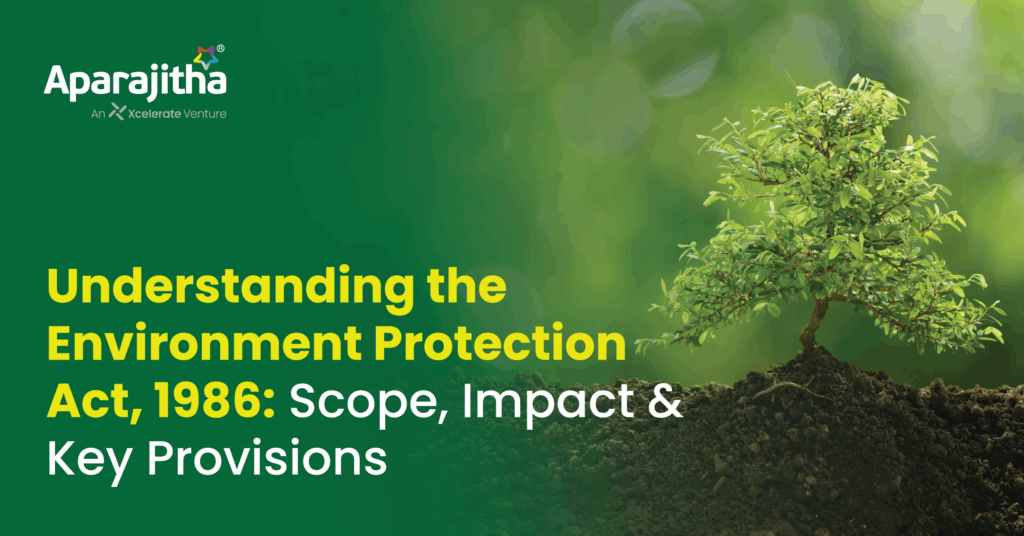In the modern era, rapid industrial growth and urbanisation have undoubtedly contributed to economic development, but they have also placed enormous pressure on our natural environment. Pollution of air, water, and soil, along with increasing deforestation and biodiversity loss, highlighted the urgent need for strong legislation to safeguard the environment in India. Against this backdrop, the Environment Protection Act, 1986 was enacted as a comprehensive legal framework to address environmental challenges holistically.
Often referred to as the “umbrella act”, it consolidates and strengthens existing environmental laws while empowering the central government with wide-ranging powers to protect and improve the quality of the environment. This blog explores the scope, impact, and key provisions of the Environment Protection Act (EPA), 1986, while also connecting its relevance to modern concepts such as EHS compliance (Environment, Health, and Safety).
Background: Why Was the Environment Protection Act, 1986 Enacted?
The seeds of the Act were sown after the Bhopal Gas Tragedy of 1984, one of the world’s worst industrial disasters, which killed thousands and exposed the lack of adequate legal safeguards in India. The tragedy underscored the urgent need for a robust legal framework to regulate industrial activity and prevent environmental hazards.
In response, India enacted the Environment Protection Act, 1986, under Article 253 of the Constitution, giving effect to decisions made at the United Nations Conference on the Human Environment, 1972 (Stockholm Conference). Unlike earlier laws such as the Water (Prevention and Control of Pollution) Act, 1974, or the Air (Prevention and Control of Pollution) Act, 1981, the EPA was designed as a comprehensive umbrella legislation covering all aspects of environmental protection.
Scope of the Environment Protection Act, 1986
The scope of the EPA is broad and inclusive, ensuring that environmental protection is addressed from multiple dimensions. Some major aspects include:
- Comprehensive Coverage:
Unlike sector-specific laws, the EPA covers air, water, soil, noise, and biodiversity under a single framework, making it the umbrella act for environmental regulation in India. - Preventive and Punitive Measures:
The Act emphasises not only controlling pollution but also preventing environmental hazards through standards, restrictions, and guidelines. - Wide Definition of Environment:
The EPA defines “environment” to include water, air, land, and the interrelationship among them with human beings, flora, fauna, and property. - Empowering the Central Government:
The Act vests the central government with authority to issue directions, set standards, regulate industries, and enforce compliance across the country.
Thus, the EPA goes beyond simply being a regulatory mechanism; it lays down the foundation for sustainable development by integrating environmental concerns into economic planning.
Key Provisions of the Environment Protection Act, 1986
The strength of the EPA lies in its detailed provisions, which are flexible yet stringent enough to address diverse environmental challenges. Some of the key provisions include:
1. Powers of the Central Government
Under Chapter II of the Environment Protection Act, 1986, the Central Government is entrusted with extensive authority to ensure environmental protection and regulation across the country. Some of its key powers include:
- Power to Take Measures for Environmental Protection: The government can take all necessary steps to protect and improve the environment, prevent pollution, and safeguard public health.
- Power to Set Standards: It can set standards for emissions and discharges, restrict or prohibit the use of hazardous substances, and regulate the location and operation of industries that impact the environment.
- Power to Appoint Officers and Authorities: The government may appoint officers or constitute authorities responsible for implementing the provisions of the Act and coordinating enforcement activities.
- Power to Make Rules and Notifications: It can frame rules, issue guidelines, and publish notifications under various sections of the Act to ensure effective implementation.
- Power to Direct and Regulate: The Act empowers the Central Government to issue directions to any person, officer, or authority—including orders to close, prohibit, or regulate industries or processes that violate environmental norms.
2. Standards and Guidelines
- The Act empowers authorities to lay down standards for the quality of air, water, and soil, ensuring that environmental parameters are maintained within safe limits.
- It also allows for the creation of safeguards for handling hazardous substances and chemical waste, and for the prevention, control, and abatement of environmental pollution.
3. Control of Hazardous Substances
- Special provisions are included to regulate industries dealing with toxic or hazardous substances, which include any chemical or material that, by its nature or handling, can cause harm to humans, other living organisms, or the environment — such as flammable chemicals, corrosive acids, toxic metals, pesticides, and industrial solvents.
- Guidelines are issued to prevent accidents like the Bhopal Gas Tragedy and minimize risks to human health and the environment.
4. Penalties and Offences
- Violations of the Act can lead to imprisonment of up to 5 years or fines up to ₹1 lakh, or both.
- In case of continued violations, additional fines of ₹5,000 per day can be imposed.
- If the failure continues beyond a year, imprisonment may extend to 7 years.
5. Citizen Empowerment
- The EPA allows any citizen to file a complaint regarding environmental violations after giving 60 days’ notice to the authorities.
- This provision empowers individuals and NGOs to act as watchdogs for environmental protection.
Impact of the Environment Protection Act, 1986
Since its enactment, the EPA has had far-reaching impacts across industries, communities, and governance:
- Foundation for Environmental Governance:
It laid the groundwork for a wide range of environmental rules and notifications issued under its framework, such as the Environmental Impact Assessment (EIA) Notification, 2006, Hazardous Waste Management Rules, and Biomedical Waste Management Rules. Over the years, several other important regulations have also been notified under the Environment Protection Act, including the E-Waste Management Rules, Plastic Waste Management Rules, Battery Waste Management Rules, Construction and Demolition Waste Management Rules, and the Coastal Regulation Zone (CRZ) Notification, all of which aim to address specific areas of environmental concern. - Promotion of EHS Compliance:
The Act encouraged industries to adopt EHS compliance practices by making it mandatory to follow safety and environmental guidelines. Companies now integrate environmental safeguards into their operations to avoid penalties and reputational damage. - Stronger Institutional Mechanisms:
It strengthened regulatory authorities like the Central Pollution Control Board (CPCB) and State Pollution Control Boards (SPCBs), making them more accountable and effective. - Awareness and Public Participation:
By enabling citizens to raise complaints, the EPA promoted transparency and community participation in environmental protection. - Corporate Responsibility:
Industries are now more conscious of adopting green technologies, waste reduction measures, and sustainable practices, aligning with global ESG (Environmental, Social, and Governance) trends.
Environment Protection Act and EHS Compliance
The link between the EPA and EHS compliance is significant in today’s industrial landscape. EHS compliance refers to adherence to environmental, health, and safety standards within organisations.
- Legal Mandate: Under the EPA, industries must ensure emissions, waste disposal, and hazardous substances management are in line with prescribed standards.
- Risk Mitigation: Effective EHS compliance reduces the likelihood of accidents, pollution, and legal action.
- Sustainable Growth: By aligning business operations with EPA standards, companies contribute to sustainable development goals.
- Global Competitiveness: In an era where global supply chains emphasize green compliance, adherence to EPA provisions enhances India’s competitiveness in international trade.
Thus, the EPA acts as the backbone of India’s EHS compliance framework.
Challenges in Implementation
Despite its significance, the EPA faces challenges:
- Enforcement Issues: Regulatory bodies often struggle with manpower, resources, and coordination.
- Industrial Resistance: Some industries view compliance as a cost burden rather than an investment in sustainability.
- Public Awareness: Citizens may not always be aware of their rights and responsibilities under the Act.
- Evolving Risks: Emerging threats such as climate change, electronic waste, and microplastics require constant updating of rules.
The Road Ahead
Nearly four decades after its enactment, the Environment Protection Act, 1986 continues to remain central to India’s environmental governance. However, its effectiveness depends on robust implementation, industry cooperation, and active citizen participation.
To strengthen the Act’s role:
- Regulatory bodies must be modernised with digital monitoring tools.
- Industries should adopt green technologies and prioritise EHS compliance.
- Public awareness campaigns should be intensified to involve communities in environmental decision-making.
- The Act must evolve continuously to address emerging environmental threats.
Conclusion
The Environment Protection Act, 1986 stands as a landmark legislation in India’s journey toward sustainable development. As an umbrella act, it integrates fragmented environmental laws into a cohesive framework, empowering the government, industries, and citizens alike to safeguard natural resources.
By promoting EHS compliance and accountability, the Act not only protects the environment but also ensures human health and safety. While challenges in enforcement persist, the EPA remains a powerful tool for balancing economic growth with ecological preservation.
In today’s context of global climate challenges, the relevance of the EPA is more critical than ever. Strengthening its implementation and aligning it with modern sustainability practices will ensure that India continues to grow while protecting its environment for generations to come.







